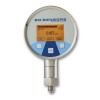 These high accuracy pressure instruments utilize precise sensor technology and digital electronics to provide accurate pressure measurement readings for test, research & calibration applications.
These high accuracy pressure instruments utilize precise sensor technology and digital electronics to provide accurate pressure measurement readings for test, research & calibration applications.
 High Accuracy, Precision & Resolution Pressure Gauges - Pressure gauges for high accuracy pressure measurement with high resolution digital displays, high precision pressure measurement technology and selectable pressure units for use in the laboratory as a secondary pressure standard.
High Accuracy, Precision & Resolution Pressure Gauges - Pressure gauges for high accuracy pressure measurement with high resolution digital displays, high precision pressure measurement technology and selectable pressure units for use in the laboratory as a secondary pressure standard.

